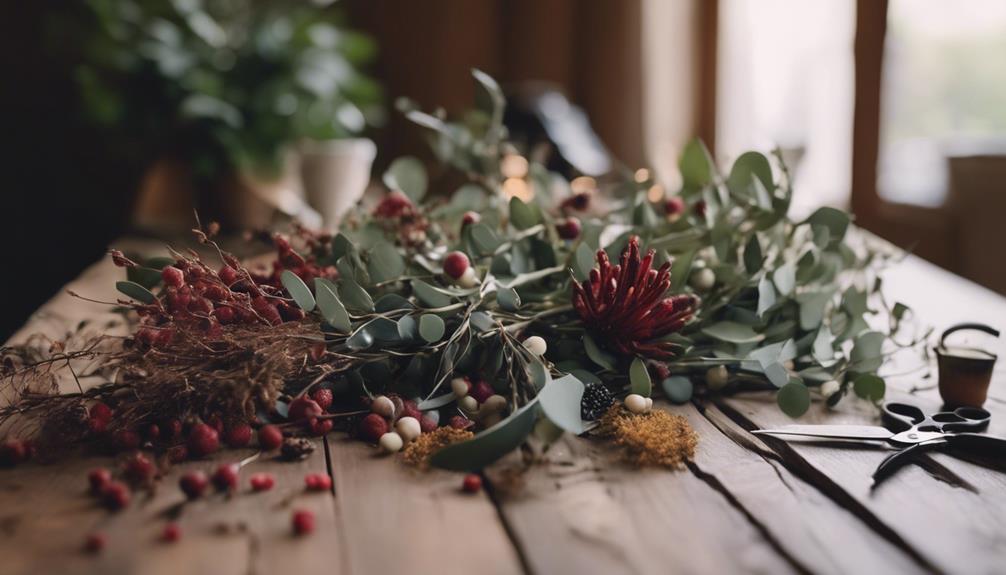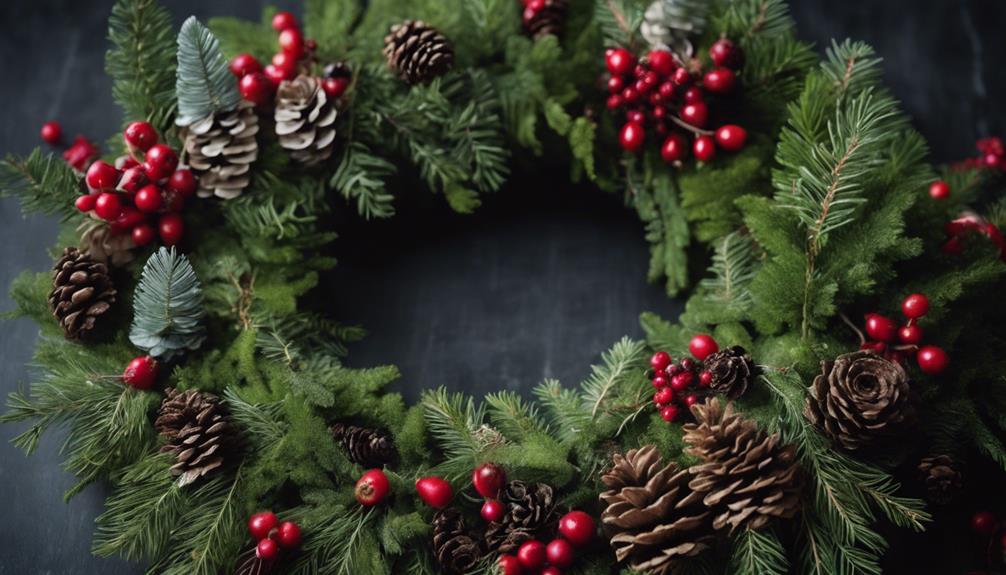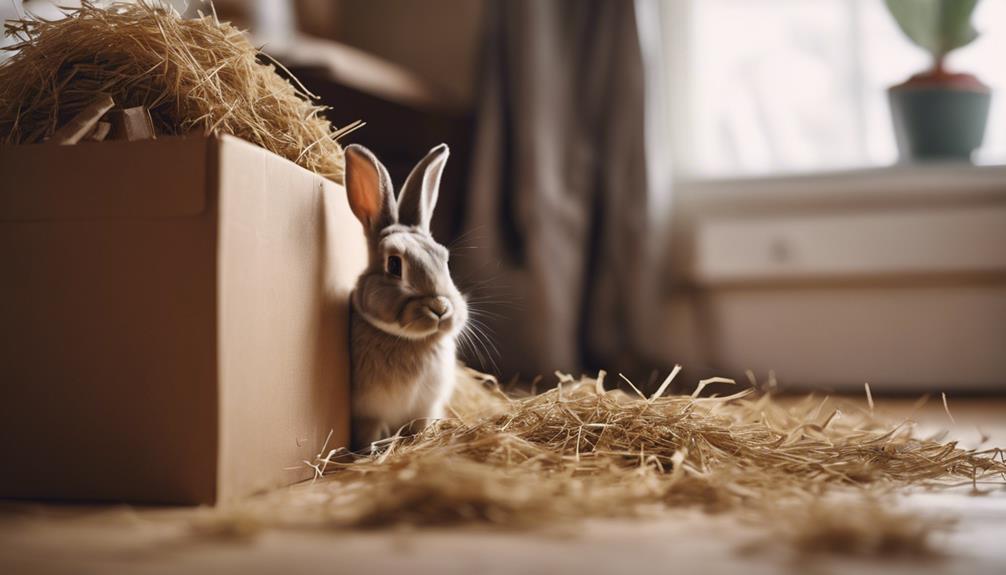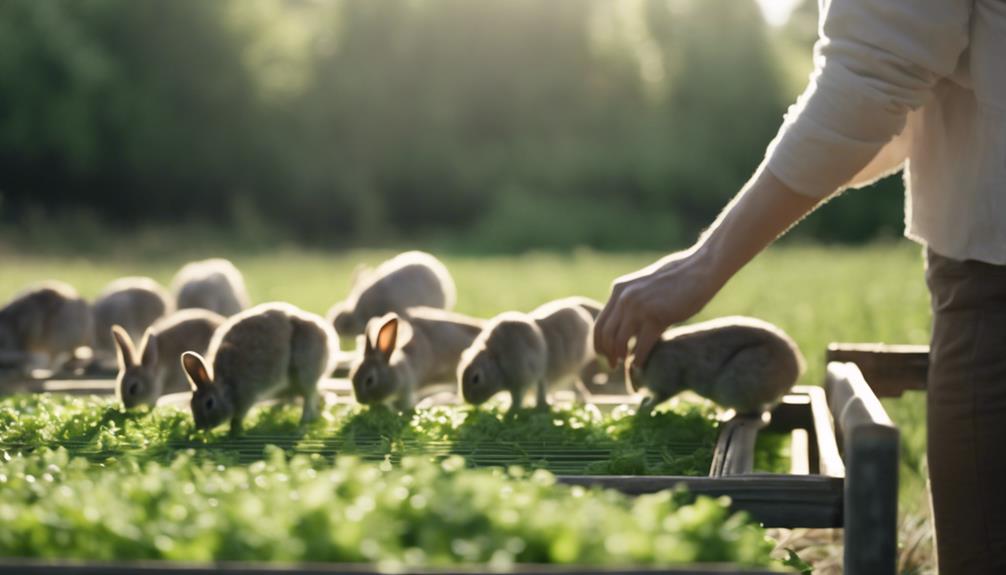Explore your home decor with beautiful handmade wreaths incorporating natural elements such as pinecones, oak leaves, and pampas grass. Easily clean and disinfect these materials by soaking, scrubbing, and even baking them for extra care. Make sure to have essential tools like wire cutters, floral wire, and a glue gun on hand to create a stunning wreath base. Follow simple step-by-step instructions to assemble a unique wreath with various textures and elements. Discover creative styling tips, warm fall welcome ideas, and sustainable winter decor concepts to effortlessly elevate your space. Embrace the beauty of nature in your decor.
Key Takeaways
- Incorporate diverse foraged materials like pine cones and magnolia seed heads for a unique look.
- Use asymmetrical arrangements for a natural and dynamic aesthetic.
- Consider mixing textures such as pods, feathers, and dried flowers for visual interest.
- Opt for a variety of colors and shapes to create a visually appealing wreath.
- Display your foraged wreath proudly on your front door or walls for a charming seasonal touch.
Foraged Materials for Stunning Wreaths
Explore your surroundings to discover a plethora of foraged materials perfect for creating stunning wreaths. Wreaths adorned with natural charm can be crafted using a variety of items like Jacaranda seed pods, pine cones, oak leaves, magnolia seed heads, acorns, pampas grass, berries, lichen, moss, and sunflowers. These foraged materials not only add texture but also bring a touch of the outdoors into your home decor.
When collecting foraged materials for wreaths, consider visiting forests, open fields, riverbanks, or even your own yard. Each location offers a unique selection of items that can enhance the beauty of your wreath. Incorporating a mix of these natural elements can result in a visually appealing and organic-looking creation that's sure to impress.
Experiment with different combinations of foraged materials to create wreaths that reflect your personal style and aesthetic preferences. Whether you prefer a rustic look with pine cones and acorns or a more vibrant display with berries and sunflowers, the possibilities are endless when crafting wreaths with foraged finds.
Cleaning and Disinfecting Foraged Finds

To prepare your foraged finds for crafting, begin by shaking off any dirt and debris before proceeding with the cleaning process. Soak the natural materials in lukewarm water to help loosen any remaining dirt, then gently scrub them with a soft brush to make sure they are clean. Remember to rinse the foraged items thoroughly after cleaning to eliminate any soap residue. Additionally, if you want to disinfect pinecones and pods, consider baking them in the oven at temperatures between 140-180°F. This method will help guarantee that your foraged finds are not only clean but also safe for use in your stunning wreath creations.
| Cleaning Steps | Explanation | Importance |
|---|---|---|
| Shake off debris | Remove initial dirt and debris to prepare materials for washing | Essential step |
| Soak in lukewarm water | Loosen remaining dirt and grime for easier cleaning process | Facilitates cleanliness |
| Gently scrub materials | Make sure thorough cleaning of the natural materials without damaging their integrity | Maintains material quality |
Essential Materials for Wreath Making

When creating wreaths, key components like pinecones, acorns, and various pods are essential for a natural and rustic look.
You'll also need tools such as wire cutters, floral wire, and a glue gun to assemble the materials securely.
Additionally, consider incorporating decorative additions like ribbons, bows, or faux berries for a personalized touch.
Key Wreath Components
Essential materials for wreath making typically include grapevine, straw, or wire wreath forms as the base. When creating a stunning foraged wreath, key components like natural elements and foraged items play an essential role. Incorporating pinecones, acorns, various pods, and branches adds texture and visual interest to your wreath design. To enhance the durability and aesthetics of your creation, consider varnishing the wreath form, branches, and foraged pods. Adding leaves, flowers, feathers, and other foraged natural elements with wire and glue can further elevate the beauty of your wreath. For a unique touch, customize your design with birch branches or small vines. Below is a table outlining the essential components for crafting a captivating foraged wreath:
| Component | Description | Example |
|---|---|---|
| Base | Grapevine, straw, or wire wreath form | Grapevine wreath form |
| Foraged Items | Pinecones, acorns, pods, branches | Pinecones |
| Natural Elements | Leaves, flowers, feathers | Leaves |
| Customization | Birch branches, small vines | Birch branches |
| Varnishing Supplies | Varnish, brushes, protective gear | Varnish bottle |
Must-Have Tools
You'll need wire cutters, floral wire, a hot glue gun, and scissors as essential tools for wreath making.
Here are some must-have tools for creating beautiful fall wreaths using natural materials:
- Wire Cutters: These are essential for trimming branches, stems, and wires to the desired length, ensuring a neat and professional-looking finish to your wreath.
- Floral Wire: Floral wire is indispensable for securing natural elements like leaves, flowers, and berries onto the wreath base, keeping everything in place and adding stability to your design.
- Hot Glue Gun: A hot glue gun is invaluable for attaching heavier items, such as pinecones or acorns, to your wreath securely. It provides a quick and strong bond, ideal for ensuring your decorations stay put throughout the season.
Decorative Additions
To elevate your wreath-making process, consider incorporating decorative additions like grapevine wreath forms, straw wreath forms, or wire wreath forms as essential materials. These forms provide a sturdy base for your wreath and can enhance the overall aesthetic appeal. Additionally, foraged materials such as pinecones, acorns, and pods can be creatively used to add texture and interest to your creations. Crafting supplies like wire, glue, and varnish are essential for assembling and styling foraged wreaths, ensuring durability and longevity. Moreover, adding elements like feathers, poppy pods, and dried flowers can further enhance the visual impact of your wreaths. Once your foraged wreath is complete, displaying it on your front door or walls can bring a touch of seasonal charm to your home decor.
| Decorative Additions | Benefits |
|---|---|
| Grapevine Wreath Forms | Sturdy base for wreaths |
| Straw Wreath Forms | Natural and rustic look |
| Wire Wreath Forms | Versatile and customizable |
| Foraged Materials | Adds texture and interest |
| Crafting Supplies | Essential for assembly |
Step-by-Step Wreath Assembly Guide

To assemble your foraged wreath, gather your materials like pinecones, acorns, and pods along with a wreath form. Begin by attaching the base components to the form securely with wire and glue, adding personalized touches like birch branches or vines.
Follow the step-by-step instructions to craft a beautiful wreath that reflects your creativity and connection to nature.
Materials Needed
Consider gathering pinecones, acorns, and various pods as the primary materials for your foraged wreath. To create a stunning and natural wreath for your front door, you'll need the following materials:
- Pinecones: These can add texture and a rustic charm to your wreath. Look for different sizes and shapes to create visual interest.
- Acorns: Small acorns can be a delightful addition, bringing a touch of nature to your wreath. Consider painting them in metallic hues for a modern twist.
- Various Pods: Pods come in a variety of shapes and sizes, offering unique textures to your wreath. Preparing them by baking, cooling, and storing will make sure they're ready for use in your wreath.
Gathering these natural materials will provide the base for a beautiful foraged wreath that you can customize to suit your style and elevate your home decor.
Assembly Instructions
Prepare your workspace with all the disinfected materials and tools required for assembling your foraged wreath. Depending on the time of year, you may need to preheat your oven to 140-180°F to disinfect pinecones and pods before incorporating them into your design.
Start by selecting a wreath form, branches, leaves, pods, flowers, and other natural elements you've gathered. Follow this step-by-step guide for assembling your stunning foraging wreath:
- Securely attach the leaves, pods, and flowers to your wreath form using a combination of wire and glue.
- Varnish the branches, wreath form, and pods to protect them from the elements and enhance their natural beauty.
- Create a hanger loop on the back of your wreath for easy hanging on your front door or wall.
Creative Ways to Style Your Wreath

Looking to elevate the visual appeal of your wreath? Here are some creative ways to style your grapevine wreath using asymmetrical designs and foraged materials:
- Mix Textures:
Incorporate a variety of textures like pinecones, acorns, and pods in your wreath to add visual interest and depth. The combination of different materials will create a dynamic look that catches the eye.
- Embrace Asymmetry:
Opt for asymmetrical designs when arranging your foraged materials on the grapevine wreath. This approach will help achieve a more natural and organic look, enhancing the overall appeal of your creation.
- Play with Heights:
To add dimension to your wreath, strategically place stems at varying heights. This eye-guided placement technique will create a sense of balance and movement, making your wreath visually engaging from all angles.
Tips for a Warm Fall Welcome

Create a cozy autumn ambiance with a welcoming fall wreath adorned with natural elements and seasonal textures. To achieve a warm fall welcome, consider using foraged materials like pine cones, acorns, maple leaves, jacaranda seed pods, and pampas grass in your wreath. These elements add unique textures and a touch of nature to your fall decor.
Additionally, incorporating oak leaves, corn husks, and berries can enhance the rustic and seasonal feel of your wreath.
When making wreaths with foraged finds, it's crucial to clean and disinfect them properly. Soak the materials in water, scrub gently, and consider baking pine cones and pods in the oven to make sure they're free from pests and dirt.
Once your foraged wreath is ready, display it proudly on your front door or wall to celebrate the beauty of nature and creativity in your home decor. Embrace the spirit of fall with a handmade wreath that reflects the charm of the season.
Sustainable Winter Decor Ideas

Enhance your winter home decor sustainably by incorporating foraged materials like pinecones, acorns, and branches into your stunning wreaths and arrangements. To create a nature-inspired and eco-friendly ambiance in your living space, consider the following sustainable winter decor ideas:
- Incorporate a Variety of Foraged Materials:
Gather pinecones, acorns, and branches from your surroundings to add a rustic and natural touch to your decor. These items not only bring a sense of the outdoors inside but also reduce the need for store-bought decorations, promoting sustainability.
- Add Nature-Inspired Elements:
Integrate berries, lichen, and moss into your winter decor to enhance the cozy atmosphere of your home. These elements not only provide visual interest but also connect your space to the beauty of the natural world, making your decor more inviting and aesthetically pleasing.
- Utilize Natural Textures and Colors:
Embrace the textures and colors found in foraged foliage to bring warmth and depth to your winter decorations. By utilizing the inherent beauty of these materials, you can create a harmonious and sustainable decor scheme that celebrates the season and the environment.
Frequently Asked Questions
How to Make a Wreath Foraging?
To make a wreath foraging, gather natural materials like pinecones and acorns. Clean and disinfect your finds. Attach them to a wreath form with wire and glue. Add seasonal elements for a unique look. Display proudly!
What Greenery Is Good for a Wreath?
For a wreath, good greenery choices include pine, cypress, eucalyptus, holly, and ivy. Mix various types for texture. Evergreens like pine and cedar last long. Fragrant herbs like rosemary, bay, and sage add pleasing scents.
How Can I Spice up My Wreath?
To spice up your wreath, mix textures like pine cones and acorns. Add seasonal foliage like oak leaves and bunny tails. Pop in sunflowers for color. Forage moss, lichen, and berries for depth. Get creative and sustainable by sourcing from nature.
What Kind of Foliage Do You Use for an Autumn Wreath?
For an autumn wreath, use foliage like pinecones, acorns, magnolia seed heads, oak leaves, and maple leaves for a seasonal touch. Incorporate foraged materials such as jacaranda seed pods, bottle tree pods, and pampas grass to add texture and interest.
Conclusion
To sum up, foraged wreaths can truly elevate your home decor with their unique and natural beauty. By utilizing sustainable materials and following our step-by-step guide, you can create stunning wreaths that will impress your guests and add a touch of warmth to your space.
Embrace the beauty of nature and bring a touch of the outdoors inside with these creative and eco-friendly decor ideas.










